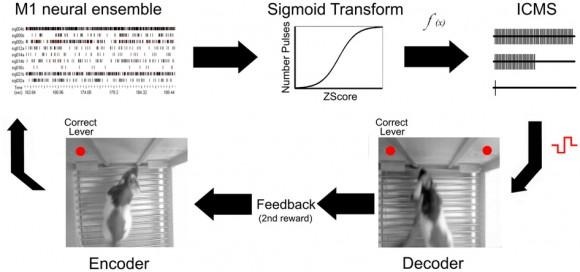Brain linked rats pave way for Gibson-esque meat crowd-computer
Technology that allows a direct link between the brains of two rats, allowing the behaviors of one animal to shape those of the other – even if they were thousands of miles apart – could pave the way to cognitive crowd-sourcing, researchers suggest. The experiment, in which microelectrodes a 1/100th the thickness of a human hair were inserted into the parts of the rats' brains which handle motor information, saw one rat rewarded for hitting a specific lever in its cage, and then remotely tutoring its counterpart to select the correct lever in its independent cage by direct stimulation of its motor cortex.
The system basically learnt from the electrical activity in the part of the "encoder" rat's brain, as it figured out which of the levers in its cage to press, and then stimulated the "decoder" rat's brain with the same impulses. Although the second rat did eventually figure out which was the right lever on each test, however, demonstrating a roughly 70-percent success ratio, it wasn't an instantaneous process.
Instead, it took scientists around 45 days – with the rats practicing for an hour each day – before the decoder animal became proficient. That appeared to be a sudden switch in understanding, however, rather than a gradual familiarity: "there is a moment in time when ... it clicks" Professor Miguel Nicolelis of the Duke University Medical Center in North Carolina, where the research took place, said of the process.

"Suddenly, the [decoder] animal realizes 'Oops! The solution is in my head. It's coming to me' and he gets it right" the scientist says. To help that process along, the encoder rat was denied a treat whenever the decoder rat picked the wrong lever, a feedback system that encouraged sharper thoughts from the tutoring animal.
Although the current system uses a pair of rats – at times linking Duke University with a counterpart lab in Brazil – the scientists are already working on a version which will combine the thoughts of multiple animals. "You could actually have millions of brains tackling the same problem and sharing a solution" Nicolelis suggests, opening the door to a crowd-sourced problem solving engine of sorts.
"It is important to stress that the topology of BTBI [Brain-to-Brain Interface] does not need to be restricted to one encoder and one decoder subjects. Instead, we have already proposed that, in theory, channel accuracy can be increased if instead of a dyad a whole grid of multiple reciprocally interconnected brains are employed. Such a computing structure could define the first example of an organic computer capable of solving heuristic problems that would be deemed non-computable by a general Turing-machine" Professor Miguel Nicolelis, Duke University Medical Center, North Carolina
Nicolelis and his team also predict that one day – albeit a day several decades off – humans will be able to communicate and learn in this fashion, though it will take some clever cabling to actually make it practical. Currently, the microelectrodes require direct contact with points within the brain; while non-invasive brain monitoring equipment exists, it's insufficiently precise for these purposes.
According to Nicolelis, the next stage of the research is to work on the crowd-crunching potential of the system, and measure its potential for computation in comparison to more traditional systems.
[via BBC]
